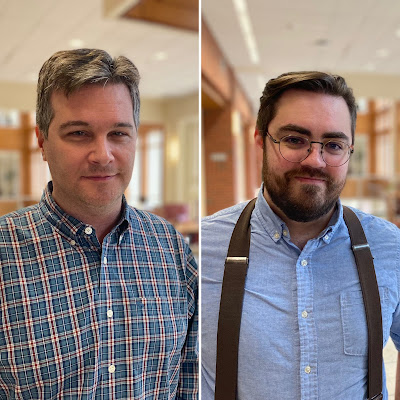OU leads port safeguarding partnership
October 6, 2008 Mouhammad Al-Akkow, left, and Adam McDonald put the hood on a small helicopter. (Photo by Kirby Lee Davis) TULSA – The mechanics differ little from the remote-control helicopter Adam McDonald flew as a teenager. But snap on a neural network software package, camera, radar or identification tag reader, and that yard-long chopper becomes a front-line defense tool for safeguarding the nation’s ports. Researchers from the University of Oklahoma demonstrated such a helicopter Friday at the Tulsa Port of Catoosa with Autonomous Aerial Robotic Systems of Goodlettsville, Tenn.Associate professor Sesh Commuri from the OU School of Electrical and Computer Engineering wheeled out a different robot built from a small all-terrain vehicle, capable of electronically monitoring shipyards, warehouses and other cargo areas. The devices offered the most colorful demonstration of how a group of professors and students at the landlocked Norman university may soon play a huge role in determining how the United States wins the war on terror in the high seas. “Freight security has long been inadequate,” said OU College of Engineering Dean Tom Landers. “But we are now making real progress.” In the $12 million project arranged three years ago by U.S. Sen. Jim Inhofe, R-Okla., OU led the formation of an industry, government and academic partnership to create an inter-modal containerized freight security system. This project, which has just completed its second of three phases, would allow companies and governments to monitor and secure freight and cargo throughout the supply chain – from when it is packed and shipped to when it arrives. Since U.S. ports take in 20,000 to 30,000 freight containers daily, averaging 40 documented items per container, monitoring each one for potential terrorist incursions presents a Herculean assignment. Open-sea piracy, drug running, disease contamination or natural disasters just compound that, Landers said Friday. The multidisciplinary group from OU tackled the subject with teams at Oklahoma State University, West Virginia University and the University of Pennsylvania Wharton School of Business, along with communications and software developer Viack Corp., national defense contractor Lockheed Martin, which focused on information management systems, and the Thompson Advisory Group, specialists in policy analysis and information-sharing agreements. Between them, the researchers studied freight movement patterns and port vulnerabilities, determined risk analysis and assessment, designed wireless identification systems to record inventories and detect changes or tampering, created encryption software and counter-measures, developed new strategies for handling and responding to potential cargo problems, tested a network of wireless communications nodes to monitor the Tulsa Port of Catoosa, and assembled automated, mobile robots to monitor and patrol ships and cargo areas. Those efforts could revolutionize how the world monitors and manages shipping, said Viack’s Stephen Overman. “Those of you with the Coast Guard will be very happy to see this,” he said. Grover Mullin, senior program manager with Lockheed Martin, demonstrated the “Safe Seas” project that cross-indexes automated ship identification systems, relayed ship radar scans and other available data systems with satellite imaging capabilities and possible aircraft surveillance, all to monitor cargo shipments, passengers and crew, assess risk threats, notify clients and assist in possible interdiction. This near-real-time maritime inter-modal transportation system, which he compared to fictional accounts presented by Tom Clancy or the television show 24, will soon become available under the name Neptune Systems. In outlining and demonstrating the programs Friday, Landers said they used economic-driven assessments and technologies to remain as cost-effective as possible. For visual surveillance, for example, Mullin said the Safe Seas system starts with satellite coverage, which costs 12 cents per square mile. At the customer’s choice, the system may then advance to unmanned aerial surveillance, at a cost of $1 to $5 per square mile, to manual aircraft at a cost of $100 to $200 per square mile, or ships, which may cost $1,000 per square mile. The mini-helicopter, based on the AeroCopter Express platform by Autonomous Aerial Robotic Systems, costs less than $38,000, said Vice President of Business Development Steve Fouche, although he noted adding radar or other systems could more than double that. But even then, he said that marks a tremendous reduction in cost from what such technology would have required three or four years ago. The OU helicopter could fly under its own control at speeds of up to 50 miles per hour, with a capacity to carry up to 20 pounds. Fouche said it also could fly in winds up to 45 mph. Commuri’s team assembled their robot from a $1,000 electric ATV capable of traveling up to 15 mph carrying 150 pounds. Adding a steering motor, navigation system and receiver and magnetic compass raised its price to $5,000. Both robot systems offered users the ability to receive and monitor freight radio tags, patrol a compound or investigate a disturbance from a safe distance. Commuri said his robot could check a shipyard of tagged containers instantaneously with a radius of 200 feet. While McDonald stood by to take over the copter by remote control if needed, Fouche said the chief pilot could just as easily have handled the controls over the Web from anywhere in the world. That level of control also illustrates how these systems may improve efficiency and productivity in the freight sector, said Mullin. “We are much safer today than we were 10 years ago,” said Landers. “Although there are still gaps to be filled.” Phase three will involve finalizing systems and integration. Landers expects that to begin next year. “Oklahoma is leading the way in protecting our homeland and worldwide commerce,” he said. by Kirby Lee Davis The Journal Record


